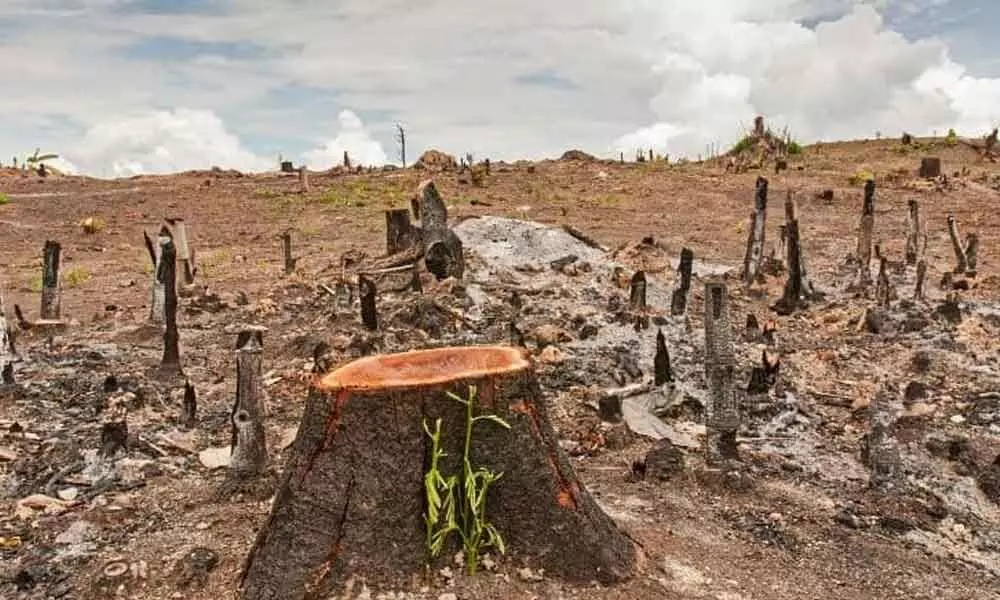Deforestation impacts rainfall pattern

Deforestation impacts rainfall pattern
The world has seen the impact of the corona virus pandemic resulting in loss of life, trillions of dollars of economic damage, job losses etc.
The world has seen the impact of the corona virus pandemic resulting in loss of life, trillions of dollars of economic damage, job losses etc. The virus was transmitted from animals to human and change in strategy is required for preventing the interaction between the two. This means ending our destruction of nature and protection and restoration of wildlife habitats.
The exploitation of nature results in wild animals straying into human habitats and transmitting virus. Deforestation is one of the key factors that have caused other pandemics and will cause them in future as well. Our leaders need to realize that we cannot have healthy economics without healthy ecology and environment.
Creation of coal corridor is planned in Sagarmala's Mormugao port development project in Goa. The port presently handles 10 million metric tons per annum (MMTA) of coal and is being upgraded to 50 MMTA by 2030. Up-gradation of infrastructures for transporting it to hinterland is the reason for road widening and rail line doubling.
Proposals to widen the width of NH 4A from Belgavi to Panjim and doubling the rail track through Castle Rock- Kullem-Madgaon are already approved by both States -- Karnataka and Goa. The projects involve the destruction of pristine forests of Western Ghats and wildlife habitats in Mollem National Park and Mahaveer Wildlife Sanctuary of Goa and forest areas through Anshi National Park (Kali Tiger Reserve) of Karnataka. Third linear project of 400 KV transmission line for evacuation of power from Kaiga (Karwar) to Goa is also in the pipeline. Amidst the protests, the widening of the road in Karnataka is completed, while the work is not yet started in Goa. Rail projects in both the States are in advance stage of completion in non forest areas. Even forests have already been cleared for the sub-stations relating to transmission line projects in Goa. Totally 379 ha forests in Goa and 220 ha in Karnataka are to be sacrificed for the three projects. Recently, the Government of Karnataka has ordered felling of 5,500 trees in forests and a tiger reserve and allowed construction of a rail line. Central Empowered Committee (CEC) of Supreme Court of India has inspected all three projects of both the States and recommended shelving of the rail line doubling as well as transmission line projects. They have advised to utilize the corridor already created for old transmission line for evacuation of power. National Tiger Conservation Authority (NTCA) has not favoured the projects for the integrity of tiger landscape. Environment Impact Assessment for the projects is insisted by both CEC and NTCA.
Karnataka has many more projects proposing to sacrifice Western Ghats forests. 800 ha forests of Uttara Kannada district are proposed to be sacrificed for a rail project between Hubbali and Ankola; 200 ha forests of Saravathy valley lion tailed macaque sanctuary are to be destroyed for pump storage hydroelectric project. Of course, the High Court of Karnataka has granted stay on these two for the time being, but survey on another rail project between Talguppa and Havery via Sirsi through dense forests is in progress. Many road widening projects in Western Ghats areas are in the pipeline.
This leads to fragmentation and degradation of ecologically sensitive Western Ghats forests. The forests are mothers of rivers. And are also the catchments for several east flowing and west flowing rivers providing a range of ecological services. The roots of the trees act like sponge and store rain water. It is slowly released in summer months making the flow of water in streams, tributaries and rivers perennial. If the forests are lost the flow of water becomes seasonal impacting the life of millions of people not only in Goa and Karnataka but also in Andhra Pradesh and Telangana.
The forests along the coast also perform an important role of bringing rains on hinterlands. Deforestation is linked to declining precipitation.
Two physicists, named A M Makarieva and V G Gorshkov from St Petersburg Nuclear Physics Institute, Russia have studied and brought out a paper titled "Biotic pump of atmospheric moisture as driver of the hydrological cycle on land", which was published in "Hydrology and Earth System Sciences" on 27th March 2007. Water from the land flows in oceans under gravity and the loss of water from land is continuously compensated by atmospheric transport of moisture from ocean to land. The physicists have found that air fluxes can transport moisture over non forested areas for few hundred kilometers; precipitation decreases exponentially with distance from ocean. In contrast precipitation over extensive natural forests is independent of distance from ocean for several thousand kilometers. This explains the existence of an active biotic pump transporting atmospheric moisture inland from the ocean.
Due to high leaf area index, tropical evergreen forests of Western Ghats maintain high evaporation fluxes, which "suck in" moist air from the ocean, causing enhanced precipitation at any distance from the coastline. The evidences testify that an intense terrestrial water cycle is unachievable without extensive forests.
This way hydrological cycle drives mass circulation of air, and can be understood to be driven by processes of convection that takes place over extensive forests. The 'fuel' for the convection being high rate of water vapor pumping from closed canopy vegetation. If the forests are to disappear or fragment, then moisture would no longer be sucked in, the land would dry out and turn into desert. Hinterlands without vast forests from coastline are deserts; west Asian countries are the examples.
We are fortunate to have good quality forests along the coast and also in interiors, generally supporting good amount of rainfall in the country.
Youths of Goa have come on streets to protest against sacrificing forests for the said projects. Political parties have also blamed each other for approval of the projects. The Goa government has conceded to protesters and has written to the Center to bring down the import of the coal. Moreover coal bearing areas are generally thickly wooded; import of coal is better than extracting our own coal, as we do not have to destroy our carbon sink.
The country is on green energy trajectory and PM has committed for a capacity of 175 Giga Watt solar power projects by 2024 and 450 Giga Watt by 2030. There is no need of expanding the infrastructure for coal powered projects, when Coal India and NTPC themselves are planning for green energy and are committing to become carbon neutral within next few years.
There are enough signals like current heat waves in Delhi, Haryana, and Rajasthan etc in our own country and also in western Canada and north western United States where there is unprecedented rise in temperature; we must stop destruction of nature.
(The author is retired Principal Chief Conservator of Forests (head of forest force) Karnataka)















